
Risk is an inherent part of investing, and successful financial risk management requires balancing potential risks with potential rewards. While it is not possible to eliminate investment risk entirely, investors can take steps to manage it and avoid unnecessary losses. This involves understanding the basics of risk, how it is measured, and the various types of risk, such as market risk, business risk, and liquidity risk.
One of the most important strategies for managing investment risk is diversification, which involves spreading investments across different asset classes, sectors, and industries. Diversification helps to reduce the impact of major market swings and single-security risk. Another strategy is dollar-cost averaging, which involves investing a fixed amount at regular intervals, regardless of market performance. This approach can help investors avoid making emotional investment decisions.
Additionally, investors should consider their risk tolerance, which is influenced by factors such as age, financial goals, and timeline. By assessing their risk capacity, need, and emotional response to risk, investors can make more informed decisions about their investment portfolios.
Other risk management techniques include avoidance, retention, sharing, transferring, and loss prevention and reduction. Overall, by implementing these strategies and gaining a deeper understanding of risk, investors can better protect their capital and work towards achieving their financial goals.
| Characteristics | Values |
|---|---|
| Risk measurement | Standard deviation, beta, Value at Risk (VaR), Capital Asset Pricing Model (CAPM) |
| Risk management strategies | Avoidance, retention, sharing, transferring, loss prevention and reduction |
| Risk types | Systematic risk, unsystematic risk, business risk, operational risk, credit or default risk, country risk, foreign-exchange risk, interest rate risk, reinvestment risk, political risk, counterparty risk, liquidity risk, model risk |
| Risk reduction | Diversification, hedging, dollar-cost averaging, portfolio rebalancing, investing consistently, getting an investment risk analysis, requiring a margin of safety, establishing a maximum loss plan |
What You'll Learn

Understand the basics of risk and how it is measured
Risk is defined in financial terms as the chance that an investment's actual gains will differ from an expected outcome or return. This includes the possibility of losing some or all of an original investment.
Quantifiably, risk is usually assessed by considering historical behaviours and outcomes. In finance, standard deviation is a common metric associated with risk. Standard deviation provides a measure of the volatility of asset prices in comparison to their historical averages in a given time frame. A high standard deviation indicates a lot of value volatility and therefore a high degree of risk.
Other common measures of risk include alpha, beta, R-squared, the Sharpe ratio, and Value at Risk (VaR).
Alpha measures risk relative to the market or a selected benchmark index. Beta measures the volatility or systematic risk of a fund in comparison to the market or a selected benchmark index. R-squared measures the percentage of an investment's movement attributable to movements in its benchmark index. The Sharpe ratio measures performance as adjusted by the associated risks. VaR is a statistical measure of the potential loss in value of a risky asset or portfolio in a given period for a given confidence interval.
In addition to these measures, individuals, financial advisors, and companies can develop risk management strategies to help manage risks associated with their investments and business activities.
Investment Strategies: University of Michigan's Portfolio Management
You may want to see also

Learn the risks that can apply to different scenarios
Investment risk can be broadly categorized into two types: systematic risk and unsystematic risk. Systematic risk, also known as market risk, affects the entire economic market or a large percentage of it. It is caused by factors such as political and macroeconomic risks and cannot be easily mitigated through portfolio diversification. On the other hand, unsystematic risk is specific to a particular industry or company and can be mitigated through diversification.
Systematic Risks
- Interest Rate Risk: Fluctuations in the general level of interest rates can affect the value of investments, especially bonds.
- Market Risk: Changes in the market price of securities can lead to market risk as investors tend to follow market directions.
- Reinvestment Risk: The risk that market interest rates may decrease when payments from an investment are received, impacting reinvestment options and returns.
- Inflation Risk: Inflation reduces an individual's purchasing power over time.
- Currency or Exchange Rate Risk: Changes in currency exchange rates can impact the price of assets when investing in foreign countries.
Unsystematic Risks
- Business Risk: This is associated with a company's ability to operate profitably and is influenced by factors such as management, products, marketing, financial strength, and business plan.
- Financial Risk: This is related to the amount of debt a company has and its financial structure. Highly leveraged firms have greater financial risk.
- Credit or Default Risk: The risk of a borrower failing to meet their contractual obligations, impacting bond investors.
- Liquidity and Marketability Risk: The uncertainty of converting an investment into cash quickly and at or near the quoted market price.
- Event Risk: The possibility of an unanticipated damaging event affecting a security, such as regulatory changes, fraud disclosure, negative media attention, etc.
Time Management: Can You Handle Your Investments Personally?
You may want to see also

Diversify your portfolio
Diversifying your portfolio is a key strategy for managing investment risk over time. The basic principle is simple: don't put all your eggs in one basket. Diversification is about spreading your investments across different types of assets, industries, sectors, and geographic locations to reduce the potential for loss. Here are some detailed instructions on how to diversify your portfolio:
Diversify Across Asset Classes
Asset classes such as stocks, bonds, cash, real estate, cryptocurrencies, and precious metals tend to behave differently under similar market and economic conditions. For example, stocks and corporate bonds differ from government T-bills in that they do not offer guaranteed principal and interest. By diversifying across asset classes, you can reduce the impact of major market swings on your portfolio.
Diversify Within Each Asset Class
Within each asset class, there are further opportunities for diversification. For example, within stocks, you can diversify by including a mix of large, small, and mid-cap stocks, as well as growth, value, and blended styles. You can also diversify geographically by investing in domestic and international stocks, including both developed and emerging markets. Similarly, within bonds, you can diversify by considering different maturities and credit qualities.
Diversify with Mutual Funds and ETFs
Mutual funds and exchange-traded funds (ETFs) are excellent tools for diversifying your portfolio. These funds typically invest in a specific asset class, such as stocks, bonds, or cash, but some are a mix of different asset classes. By holding several mutual funds and ETFs, you can achieve diversification across asset classes, as well as within each fund since they hold multiple underlying securities. This approach is also cost-effective for investors with limited funds.
Regularly Review and Rebalance Your Portfolio
Diversification is not a one-time task. It requires regular reviews and rebalancing to ensure your portfolio maintains the desired level of risk and aligns with your financial goals. Monitor your investments and make adjustments as necessary to stay on track.
Understand Correlation and Risk
When diversifying your portfolio, it's important to consider the correlation between different investments. Some assets may be more closely correlated than others, meaning their returns are influenced by similar factors. Aim for a mix of assets with varying degrees of correlation to fine-tune the amount of risk in your portfolio.
Remember, while diversification is a powerful tool for managing investment risk, it does not guarantee against losses. It's important to conduct thorough research, consider your risk tolerance, and seek personalised financial advice when making investment decisions.
Wealth Managers and Startup Investing: A Match?
You may want to see also

Consider your risk tolerance
Considering your risk tolerance is a crucial aspect of managing investment risk over time. It involves evaluating your comfort level with taking on financial risks and understanding how these risks align with your investment goals, timeline, and emotional responses. Here are some paragraphs discussing the concept of risk tolerance and its role in investment decision-making:
Risk tolerance refers to an investor's ability to withstand potential losses or negative outcomes in their investment portfolio. It is a key consideration when making investment decisions as it helps determine the types of investments and level of risk that are appropriate for an individual. Risk tolerance is usually influenced by factors such as age, financial goals, timeline, income, and personality. For example, younger investors with a longer time horizon until retirement may have a higher risk tolerance and be willing to invest in riskier assets. On the other hand, older investors nearing retirement may have a lower risk tolerance and prefer more conservative investments.
When assessing your risk tolerance, it is important to consider your risk capacity, which is the amount of potential loss you can afford without compromising your financial security. This can vary depending on your age, financial goals, and the timeline for achieving those goals. For instance, if you are heavely dependent on your investments to meet specific goals, you need to carefully balance the level of risk you are willing to take.
Emotional responses to risk are also an important aspect of risk tolerance. It is essential to understand how you react to risk and how these emotions may impact your investment decisions. Some people may experience fear and panic during market downturns, while others may approach risk with excitement and a willingness to take on more. Being aware of your emotional responses can help you make more informed decisions and avoid impulsive actions during volatile market conditions.
Risk tolerance also plays a crucial role in determining your investment strategy. Those with a higher risk tolerance may be comfortable with more aggressive investment strategies, such as investing in riskier assets or taking on short-term risks. On the other hand, individuals with a lower risk tolerance may prefer more conservative strategies, such as investing in less volatile assets or adopting a long-term investment horizon. It is important to note that risk tolerance can change over time as your financial situation, goals, and emotions evolve.
Financial advisors often use software programs and questionnaires to help clients pinpoint their risk tolerance more accurately. These tools can analyze a client's current portfolio, investment goals, and emotional responses to risk, providing a clearer understanding of their risk tolerance. This, in turn, helps in creating a more tailored and effective investment plan that aligns with the client's risk appetite and financial objectives.
Invest or Save? Where Should Your Money Go?
You may want to see also

Use hedging strategies
Hedging is a risk management strategy that investors use to offset potential losses in their investments. It involves taking an opposing position in a related asset, which can help to reduce the impact of adverse price movements. While it does not prevent negative events from happening, it can reduce their impact on an investment portfolio.
There are several effective hedging strategies that investors can use to reduce market risk. Here are some of the most common ones:
- Portfolio Construction: This strategy involves creating a diversified portfolio by investing in different asset classes such as stocks, bonds, alternative investments, and cash. By spreading their investments across various assets, investors can reduce their exposure to market risk.
- Options: Options are financial derivatives that give investors the right, but not the obligation, to buy or sell an underlying asset at a specified price within a specific time period. Investors can use options to protect against the risk of big losses by purchasing put options, which increase in value as the underlying security's price decreases.
- Volatility Indicators: Investors can track market volatility by monitoring the Volatility Index (VIX), often referred to as the "fear index." The VIX measures the implied volatility of at-the-money calls and puts on the S&P 500 index. When the VIX spikes, it indicates increased market volatility, which can help investors make informed trading decisions.
- Modern Portfolio Theory (MPT): MPT is a tool that uses diversification to create groups of assets that reduce volatility. It employs statistical measures to determine an efficient frontier for expected returns based on defined risk levels. MPT considers the correlation between different assets and their volatility to construct an optimal portfolio for a particular investor's risk tolerance.
While hedging can be an effective strategy for managing investment risk, it is important to note that it also typically reduces potential profits. Additionally, hedging strategies may involve complex financial instruments and additional costs, so it is crucial for investors to carefully consider the potential benefits and drawbacks before implementing them.
Strategies to Diversify Your Investment Portfolio Wisely
You may want to see also
Frequently asked questions
The greater the amount of risk an investor is willing to take, the greater the potential return. For example, a U.S. Treasury bond is considered one of the safest investments and thus provides a lower rate of return compared to a corporate bond, which has a higher default risk.
Investment risk can be measured by its deviation from an expected outcome. This can be expressed in absolute terms or relative to a market benchmark. One of the most common metrics for measuring risk is standard deviation, which measures the volatility of an investment's returns relative to its average returns.
There are several strategies to reduce investment risk, including diversification, asset allocation, dollar-cost averaging, and portfolio rebalancing. Diversification involves investing in a variety of assets and industries to reduce the impact of market swings on your portfolio. Asset allocation refers to weighing your investments across different asset classes such as stocks, bonds, and cash, taking into account your financial goals, risk tolerance, and time horizon. Dollar-cost averaging involves investing a fixed amount regularly, regardless of market performance, which can help you avoid emotional investment decisions.
Your risk tolerance depends on factors such as your age, financial goals, timeline, and emotional response to risk. Ask yourself questions like: How will I react to bad news? How does my stomach feel when I take risks? Am I someone who panics and exits during duress? Understanding your risk tolerance will help you make investment decisions that align with your comfort level.







